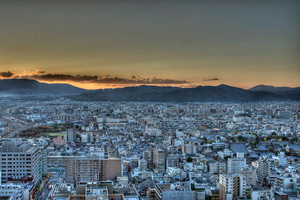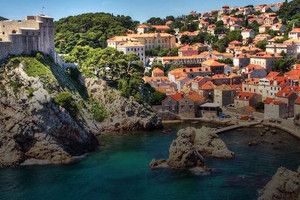
I'm standing at one of Kyoto’s most famous landmarks, attempting to ignore a large group of animated Japanese high schoolers who are comparing annoying ringtones on their mobile phones. Squinting into the low mid-afternoon sun in early November is hard enough and it's obvious Kyoto’s Kinkaku-ji Temple isn’t called the “Golden Pavilion” for nothing. It is, well, extremely golden, emitting a powerful sheen that really assaults the naked eye. Set amidst beautiful gardens in Kyoto’s northern hills, Kinkaku-ji was built in the 1390s as a retirement villa for Shogun Ashikaga Yoshimitsu. The main attraction is a three-story pavilion covered in gold leaf and topped off with a bronze phoenix, which sits astride a tranquil pond. While highly photogenic, especially on a clear day when the structure shimmers against the blue sky and the pond captures its reflection, the building isn’t an original. In 1950, a disturbed student monk burned the temple to the ground (the story is told by author Mishima Yukio in his famous novel, The Temple of the Golden Pavilion). It was rebuilt in 1955, and in 1987 was re-covered in extra thick gold leaf.
Landing In Kyoto
Like many of the 40 million or so tourists who flock to Kyoto each year, I’ve travelled there from Tokyo on a famous Shinkansen “bullet train”, for an excursion of two days. It’s a mellow ride of just under two-and-a-half hours. Passing Mount Fuji, with its famous snow-capped peak in clear view, was the only highlight. The rest of the scenery, which can whizz past at up to 300 kilometres an hour, is dominated by modern towns and industrial complexes, with the odd sweep of countryside between. I used to have an image of Japan as an idealised feudal country of teahouses and temples, castles and bamboo forests, sliding rice paper screens and raked gravel gardens. My visit to Tokyo had just spoiled that romantic notion, but if Japan’s capital city is a vision of the country’s future, then Kyoto, its former imperial capital, is a bridge to its past. Kyoto is one of the few cities in Japan untouched by World War II. It hasn’t been untouched by modern life, but much of its early heritage remains; it’s home to a fifth of Japan’s national treasures and has no less than 17 World Heritage Sights - of which Kinkaku-ji is one. It is also the atmospheric setting for the film adaptation of Arthur Golden’s bestseller Memoirs of a Geisha which hit the big screen in January, and many of Kyoto’s famous landmarks were featured in the film. My goal is to pack in as many of these as humanly possible into two days.
Kyoto Sights
On my “must do” list is Nijo-jo, or Nijo Castle. Built in 1603 as the official Kyoto residence of the first Tokugawa Shogun Ieyasu - in his day, one of the most powerful men in Japan - it’s an impressive collection of buildings and gardens dominating central Kyoto. Each beautifully maintained building tells the story of an important era in Japan’s history. And of great amusement to visitors today are the corridors with built-in "nightingale" floors, created to warn the shogun of intruders. Even the lightest step makes the wooden floor sing like the bird it’s named for. Another important sight is Heian-jingu in the city’s south east, a shrine built in 1895 to commemorate the 1100th anniversary of the founding of Kyoto. Replicas of the Imperial Court of Palace of the Heian era, the orange, green, and white architecture is undeniably striking. But the main attraction here is the Shinen Garden, famous for its weeping cherry trees in spring, irises and water lilies in summer, and the changing maple leaves in autumn.
Gion
As night falls, a popular pastime among visitors is geisha spotting. And one of the best places to do it is Gion - the geisha district made famous by Arthur Golden’s novel. Geisha are female artists who spend years training in the arts to entertain powerful men, typically in a teahouse called an ochaya. In Kyoto, they call themselves geiko. And the striking young women with white makeup, ornate black hair and bright kimonos who attract the most attention are apprentices, called maiko. Dusk is setting over the sagging, grey-tiled roofs of Gion as I arrive. It’s like a picture postcard of an almost vanished Japan - a compact neighbourhood of narrow, stone-flagged streets lined with restored wooden buildings, dubbed “the bedrooms of eels” by locals because of their long, narrow design. The pre-World War II era in which Memoirs was set is regarded as the end of golden era for Kyoto’s geisha community. From 3,000 in the early 19th century, today their numbers have dwindled to around 280 - and most of them live and work here. Spotting a real one isn’t easy; as their numbers have declined, you’re more likely to see an American tourist who has been “made over”. I walk for an hour past the sake bars, restaurants and the “by appointment only” teahouses but apart from seeing a few tourists with cameras at the ready, it’s quiet. There are no lavish parties in Gion tonight.
Geisha And Kyogen
For a guaranteed sighting, I go to Gion Corner, an entertainment venue where visitors can experience a snapshot of Kyoto's traditional culture in an hour-long show. Included are Kyogen, a form of classical comedy, court music, and a puppet show. Geiko and maiko also perform - the former demonstrating flower arranging, and the latter playing a Japanese harp called a shamisen, and performing traditional dance - which is no mean feat in full costume. After the show I go upstairs with a small group of European tourists to attend a tea ceremony - another of the geisha arts which takes years to perfect. And I learn that, in Japan, making a cuppa is far from quick. The process is fascinating, if long and complex. As guests we are very much part of the process, and have to follow precise instructions to produce a frothy green concoction called matcha. It looks like soapy green water and tastes just as unappetising, but as tea making is such an integral part of Japanese culture, taking at least a sip has to be done.
Japanese Culture
In between shrine and temple hopping, I visit the Nishijin textile district in the city’s north west, keen to see some authentic kimono. Kimono are an icon of Japanese culture and the emblem of a geisha’s calling. The kimono house of Orinasukan has fine exhibits of handmade Nishijinori fabrics and Noh costumes, and for a small fee you can access the factory floor to watch skilled craftsmen weaving by hand. At the nearby Nishijinori Textile Centre, you can see fabric painting and calligraphy demonstrations. The centre doubles up as a museum with a display of antique kimono, and it is home to one of the many “makeover” studios which have sprung up all over Kyoto. A nice diversion here is one of the free kimono fashion shows, where Japanese models show visitors how a modern twist can be applied to traditional geisha regalia. And it’s a great place to shop for traditional crafts, especially all things silk.
Kiyomizu-dera
On my last afternoon, I head out to the temple of Kiyomizu-dera - another of Kyoto’s World Heritage Listed sites. Tucked into the low mountains on the eastern side of the city, it was first built in 798 and devoted to Juichi-men Kannon, a Buddhist deity with 11 heads. The present buildings are reconstructions dating back to 1633, and perched high above the city they offer sweeping views of Kyoto and its surrounds. Filmgoers will recognise its soaring pagodas, which were frequently used as cutaways in Memoirs of a Geisha. To reach Kiyomizu-dera involves braving busloads of tourists, and an uphill climb along the busy lanes of the atmospheric Higashiyama district. The route takes you past a slew of souvenir shops, restaurants and ryokan - original Japanese guesthouses. It’s not a place to seek tranquility, but when you reach the top, the view from the verandah of the main hall makes the effort, and battling the crowds, worthwhile. The platform stretches out 10 metres over a 12-metre precipice, offering sweeping views of the city and surrounding wooded hills which are especially stunning at sunset. The temple is also fun to people-watch. One spot is from in front of the Otowa-no-taki waterfall below the main hall, where visitors line up to eagerly drink the sacred waters which are said to have therapeutic properties. Another is the Jishu Shrine, popular with women as the god of love and good marriage is believed to reside here. In front of the shrine are two rocks, placed several metres apart; successfully walking from one to the other with your eyes closed is said to bring you good luck in your love life. Eventually the crowds take their toll on my stamina, and I head back to the peace and relative quiet of my hotel.
For Next Time
I am leaving the following day, but there are still many sights I haven’t seen; the ethereal bamboo groves of Arashiyama, the pathway of red torii gates at Fushimi Inari, dozens of other shrines and temples - and a real geisha. But I am in luck. The next morning I am hunting for green tea chocolate, a Japanese delicacy, in the cavernous food hall of Kyoto’s Takashimaya department store, when a maiko resplendent in full costume comes into view. With her bright, trailing kimono, impossibly high heeled wooden sandals, ornate hairstyle and ghostly white makeup, she cannot help but catch the eye. But as she pauses to browse at a counter selling handmade chocolates, she turns toward me - she is talking on a clamshell mobile phone. This captures Kyoto in a nutshell. It’s a place where the old continues to enthral amidst the new, where a thousand-year old Shinto shrine stands untouched between a Hello Kitty Shop and a pachinko parlour. And where legendary geisha use mobile phones, and eat chocolate.
- By:
- Joanna Hall
Reviews
-
First time in Kyoto in January
We are travelling to Japan in January 2019. Kyoto is definitely on our list to stop for a few days. This article is fantastic highlighting places I had not even thought of visiting. I have read Memories of a Geisha so would love to see a glimpse of a beautiful lady while we are there. Fingers x. Great information in this article to get my plans set. Cannot wait to travel!
-
Going To Japan Next Year
We're booked to go here next year during cherry blossom season...can't wait, it's for our 20th wedding anniversary and a place we've always wanted to go. Also doing Tokyo and Osaka in the same trip....any tips you have for these places too will be gratefully received!











